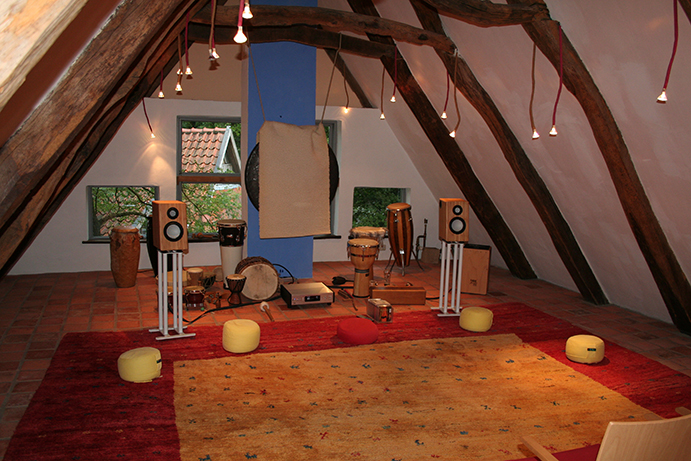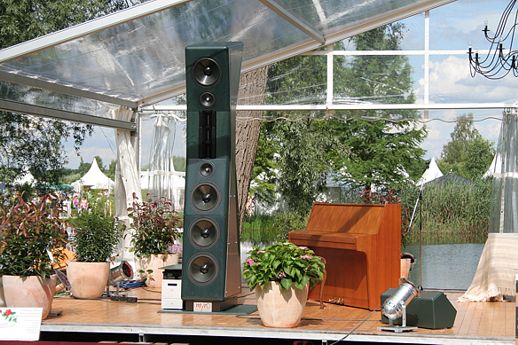Direct And Indirect Sound
Direct sound
The direct sound component reaches the listener on a direct path, without the influence of room boundaries or furnishings, without occlusion, i.e. practically with direct line of sight of the listener to the sound source. This sound component contains the only undistorted information about the sound structure of the sound source and, in the ideal case, of a correctly transducing loudspeaker or about the original sound structure of the recording. Only in direct sound is the transient / impulse characteristic audible without deformation, and this is the only information that allows us to clearly perceive what kind and characteristic the sound source is and what dynamics and time information the recording contains. This is the only place where we can really hear what kind of room sound is contained in the recording. The direct sound component in rooms, although proportionally smaller than the indirect sound, is therefore of greater importance. The recognition and localisation of sound events within the original (recording), i.e. also the recognition of the original room sound, is only clearly possible in direct sound.
Loudspeakers that do not reproduce this characteristic correctly deny us access to the other recording space. Here the image distorts and the different instruments shift according to their use and pitch.
Indirect sound
The indirect sound component and thus the sound of the listening room is largely determined by the reflections and the resonances.
Resonances
If a sound wave is reflected back and forth between parallel walls, it resonates. The distance between the walls determines the frequency spectrum of the resonance. Between the walls, depending on the frequency, there are peaks and dips in the frequency range. At the walls the fundamental resonance and its multiples have their pressure maximum. The sound image is unevenly exaggerated here, similar to a transmission line box. In large rooms the resonances are in the low bass range. However, the distances between the walls are long, so that the energy of the standing waves is relatively low (sound energy decreases with increasing distance). The bass range is therefore less bloated and sounds cleaner. Resonances in small rooms are higher in the frequency range. The wall distances are smaller, the room resonances are relatively strong, the bass is correspondingly more inflated and unclean in the middle and upper bass range.
Experiment 1:
For this you need either a frequency generator or a test CD with fixed test tones in the bass range.
Example: a 50 Hz tone.
We can now play the 50 Hz tone through our speakers. It's best to put the player on repeat.
After a few fractions of a second, we reach the steady state in the room and immediately experience the effect of room resonances. If we now move, back and forth, up and down, simply walk around the room, we know why we previously thought one speaker made a lot of bass and the other speaker made less. There is an up and down in sound pressure depending on the listening position, in some places to close to complete extinction. The loudspeaker can only be identified with the greatest of difficulty and that rather by background noise. And at every other frequency, there is a different distribution of pressure bumps and nodes. (This is what we call the peaks and dips in the sound pressure curve.)
ReflectionsReflections are of particular importance in room acoustics with regard to reverberation times. Due to their temporal delay compared to direct sound, we receive the information we need to recognize the geometry of the listening room and to localize the sound source. With regard to the reproduction of a sound recording by loudspeakers, this has the following effects: 1. in addition to the spatial information contained in the recording, we hear the spatial impression of a second room, our listening room, with its typical characteristics. These two room impressions overlap and create a more or less pronounced blurring of perception. For them it is an unfamiliar, almost absurd situation. We are not used to being in two different rooms at the same time. Listening with headphones is therefore much less stressful. However, as we have all experienced, we are quite capable, with some effort, of achieving differentiation between the two interleaved room sounds. Fortunately for us, there is a clear direct sound component, i.e. a sound component that reaches our hearing organ without the spatial influences of the reproduction room. 2. the localization of the sound source, in this case the loudspeaker, provides us with other actors besides the musicians.
To make matters worse, the miserable transient response of almost all loudspeakers (100% distortion of the first half-waves) also makes the loudspeaker locatable as a sound source. Another very significant factor is the signal deformation due to the reflection process. Here the question arises:
How do the reflections of my listening room sound? If the sound radiated by a loudspeaker hits an obstacle, e.g. a bookshelf, or is reflected by a surface or wall, its pressure-time structure (the signal structure) changes. The reflection is deformed in its sound structure, just as if it had passed through a filter. The same applies to various wall and ceiling materials. With each reflection, sound energy is selectively absorbed and converted into material vibration and heat. Non-linear absorption, the transformation of the kinetic energy of the incident sound on an object into kinetic energy and heat in the object, affects the sound waveform of the reflection. In addition, the oscillated reflecting surface adds sound energy by amplified natural oscillation at certain frequencies, or absorbs sound components by counter-phasing the natural oscillation with respect to the incident sound structure. Due to the changed sound structures we receive information about the nature of the reflecting environment, in this case about the acoustics of the reproduction room. If we sing into a wardrobe, it will sound back differently than if we sing into a shower. Sound emitted towards a reflective surface should theoretically be such that after reflection it is identical to the original signal of the recording. This is virtually impossible given the inhomogeneity of the acoustic environment. In addition, it would be unnatural, since we do not blank out the acoustic environment with it and are used to reflection sound being "filtered" by the reflection process. The intelligibility of reflected sound depends on the reflection process and usually even more on the quality of the incident sound. In other words, the quality of the sound emitted by the loudspeaker. The waveform of indirect reflected sound depends on: |
The radiation angles up to about 30° are significant for the early, high-energy, particularly influential first reflections. In a reverberant environment with relatively little filtering of the sound at the reflection surfaces, it is advantageous if the sound structures radiated by the loudspeaker all around are very similar to the original sound structures.
The loudspeaker should therefore deliver correct signals over wide radiation angles, i.e. correct results of its transfer function. The complex transfer function can be checked with the step measurement. So when comparing different loudspeakers, the step measurement should be compared at different angles. Especially radiation angles that affect near reflection angles on surfaces are of great importance here. In the mid-high range these are, due to the natural directional characteristics of higher tones, especially the near lateral reflections and those of the floor, as the only surface that is practically constant and always present in all rooms.
Depending on the application specifications of the loudspeakers and the resulting statistical average of the distances of the loudspeakers to the listening positions, corresponding reflection angles in the direction of the floor are of particular interest.
The reflection angles of the floor (usually at half the distance of the loudspeaker from the listening position) are particularly relevant in terms of room acoustics. Therefore, the thickest possible carpet is often placed at these points.
Conclusion: reflected sound no longer contains the same sound structure as direct sound and is therefore much more difficult to understand.
The indirect sound component gives us many impressions about the characteristics of our listening room. Based on our listening experience, we can tell very clearly whether we are listening to music in our living room, in the basement or in the shower.
So the higher the indirect sound component, the more everything happens in our room and the worse the reproduction of the original sound succeeds.
The first superposition with the direct sound
Basically, the reflected sound is superimposed on the direct sound with a corresponding time offset. This results in additions and subtractions due to phase shifts. The frequency response becomes very wavy, similar to angular, not very rounded loudspeaker cabinets. This phenomenon has an increasing effect in the listening room the lower the frequency radiated by the loudspeaker. Low frequencies are radiated rather broadly and therefore have a stronger influence on the reflection pattern.
Reflections that interfere (overlap) with the transient process have an almost dramatic effect.
This happens especially often in the low and fundamental range, since the first half-waves of the transient process take a longer time to develop (Hz = oscillations per second) than at high frequencies. The effect is dramatic because the deformation of the transient distorts essential information about the original sound.
Experiment 3:
We need a CD with noise, preferably pink noise, or a noise generator. In a pinch, a radio without an antenna will also help!
Then we just connect a loudspeaker and ask a friend, a girlfriend or the neighbour to help us. We now press a somewhat larger, flat object into the hands of the helping person, e.g. shelf, world atlas or similar, and place it next to the loudspeaker.
After we have made ourselves comfortable in the armchair, we now ask our helper to use the flat object as a sound reflector, to slowly approach the loudspeaker, to move away again and to position the reflector at different angles to the loudspeaker.
This experiment makes it possible to directly and practically experience the effect of reflecting objects or surfaces in the vicinity of sound sources.

Tonstudio Zimmerli, Düsseldorf, with Myro Amur D and Myro Whisky
Multi-channel playback
A major reason why multi-channel playback exists may be that the spatial reproduction of stereo was previously perceived as unsatisfactory. Almost all speakers on the market cannot reproduce signals correctly in time, but a truly convincing spatial representation depends on this. This is about the reproduction of the spatial information contained in the sound tracks. If it is not possible to reproduce this spatial information so that a plausible spatial impression is created in the listener's brain, the spatial impression of the reproduction room, the second room involved in the reproduction, will dominate. No human being can be in two different rooms at the same time! Compared to stereo, surround only has the advantage that sound can be located from further directions, thus creating an all-round localisation. Without the signal / time correct reproduction, however, it remains a limited narrow room impression with vagabond sound events and a fog of artifacts. The loudspeakers as sound source are still locatable. In order to further reduce this locatability, additional reflections are used, such as those excited by a dipole.
This increases the number of sound sources and the loudspeakers play a smaller role in the localization.
The big disadvantage, however, is that the dominance of the listening room is considerably increased, so that the spatial impression contained in the recording is increasingly lost. A loudspeaker with signal / time correct behaviour is not locatable as a sound source, it is practically transparent, transparent. Thus it is not necessary, even a hindrance, to create room reflections by a dipole characteristic. With signal- / time-corrected loudspeakers one has the chance in stereo as well as in surround mode to reproduce the original room impression of the recording to a large extent.
<zurück Myroklopädie>
<zurück Myro>


